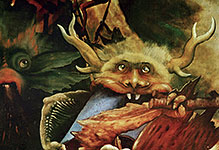
Monsters
Witches, golems, vampires, demons and more horrible creatures.

#03050440
Ulysses and the Sirens: the Greek hero Ulysses, sailing by the rock of the Siren...

#03050460
Gold belt buckle fom the ship-burial at Sutton Hoo, Suffolk, early 7th century....

#03060147
Earthenware tile with a monster mask (kwimyun) design, from Korea, Unified Sill...

#03060149
Earthenware tile, from the Red Pagoda at Mount Quingliang, Henan Province, China...

#030603 4
Bearer of the demon's head, 10th century. A Persian representation of the conste...

#03060329
Varaha with Bhu, Pahari region, North India, around 1740. The four armed Varaha...

#030701 5
Ceremonial axe from Daulatabad,Baktria,northern Afghanistan,showing a gr...

#030701 6
Ceremonial axe from Daulatabad,Baktria,northern Afghanistan,showing a gr...

#03070132
Demon,from the Monastery of Tapa-Kalan Hadda,Afghanistan. 3rd-4...

#03070144
One of many late Sasanian bowls used in magical ceremonies to protect individual...

#03070164
Horsebit from Luristan,Iran,8th-7th BCE Human headed monster tr...

#03070313
The Spider Monster Creating Monsters in the Mansion of Minamoto no Yorimitsu. Co...